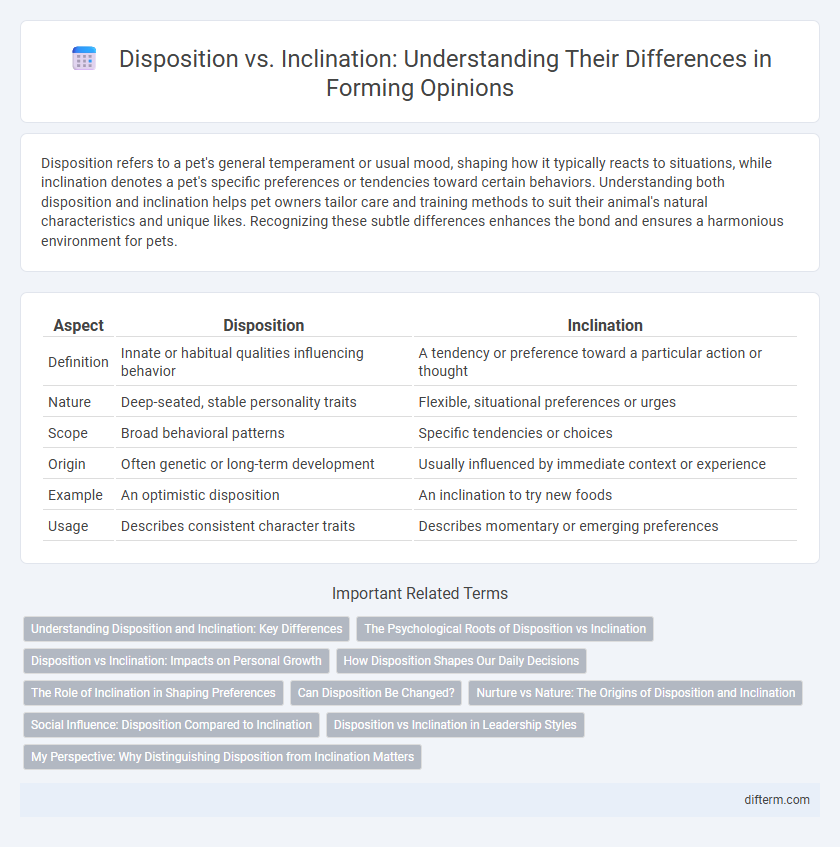Disposition refers to a pet's general temperament or usual mood, shaping how it typically reacts to situations, while inclination denotes a pet's specific preferences or tendencies toward certain behaviors. Understanding both disposition and inclination helps pet owners tailor care and training methods to suit their animal's natural characteristics and unique likes. Recognizing these subtle differences enhances the bond and ensures a harmonious environment for pets.
Table of Comparison
| Aspect | Disposition | Inclination |
|---|---|---|
| Definition | Innate or habitual qualities influencing behavior | A tendency or preference toward a particular action or thought |
| Nature | Deep-seated, stable personality traits | Flexible, situational preferences or urges |
| Scope | Broad behavioral patterns | Specific tendencies or choices |
| Origin | Often genetic or long-term development | Usually influenced by immediate context or experience |
| Example | An optimistic disposition | An inclination to try new foods |
| Usage | Describes consistent character traits | Describes momentary or emerging preferences |
Understanding Disposition and Inclination: Key Differences
Disposition refers to a person's inherent qualities of mind and character that shape consistent reactions across various situations, while inclination indicates a temporary or situational tendency toward a particular action or preference. Understanding disposition involves recognizing stable personality traits that influence behavior long-term, whereas inclination reflects momentary or circumstantial desires that may change over time. Distinguishing these concepts clarifies how underlying traits differ from situational motivations in shaping human behavior.
The Psychological Roots of Disposition vs Inclination
Disposition stems from deep-rooted personality traits shaped by genetic and early environmental influences, establishing a consistent behavioral pattern. Inclination arises from situational factors and learned experiences, reflecting temporary preferences or urges that can fluctuate over time. Psychological studies reveal that disposition is linked to stable temperamental foundations, whereas inclination is more responsive to cognitive evaluations and emotional states.
Disposition vs Inclination: Impacts on Personal Growth
Disposition reflects a person's inherent qualities shaping consistent behavior patterns, while inclination denotes specific desires or tendencies that influence choices. Understanding the balance between disposition and inclination is crucial for personal growth, as disposition forms the foundation of character, whereas inclination drives motivation and adaptability. Cultivating awareness of both allows individuals to harness stable traits and flexible preferences to achieve meaningful self-improvement.
How Disposition Shapes Our Daily Decisions
Disposition profoundly influences daily decisions by establishing consistent behavioral patterns that guide reactions and choices across various situations. Unlike fleeting inclinations, a disposition reflects an ingrained character trait that predisposes individuals toward specific responses, affecting everything from interpersonal interactions to problem-solving approaches. Understanding one's disposition enables better self-awareness and adaptive decision-making, ultimately shaping personal and professional outcomes.
The Role of Inclination in Shaping Preferences
Inclination plays a crucial role in shaping preferences by reflecting an individual's natural tendencies and desires that guide decision-making processes. Unlike disposition, which implies a more fixed or inherent trait, inclination represents a dynamic and evolving internal drive influenced by experiences and context. Understanding inclination allows for a deeper insight into why people favor certain choices, revealing the motivating factors behind personal and collective preferences.
Can Disposition Be Changed?
Disposition refers to the inherent qualities of a person's character, often shaped by genetics and early life experiences, making it relatively stable over time. Inclination involves preferences and tendencies that can fluctuate based on circumstances and conscious effort. While deep-seated dispositions are challenging to change completely, targeted interventions and sustained behavioral adjustments can gradually influence and modify them.
Nurture vs Nature: The Origins of Disposition and Inclination
Disposition and inclination stem from intricate interactions between genetic predispositions and environmental influences, where nurture shapes the expression of innate tendencies. Studies in behavioral genetics reveal that while disposition may be largely innate, inclination often develops through life experiences and social context. Understanding the balance between nature and nurture is essential for grasping how personality traits and preferences evolve over time.
Social Influence: Disposition Compared to Inclination
Disposition reflects enduring personality traits that consistently influence behavior across various social contexts, while inclination denotes more temporary, situational tendencies shaped by immediate social cues. Disposition drives long-term social interactions and attitudes, providing a stable framework for social influence, whereas inclination fluctuates according to environmental factors and peer pressure. Understanding the distinction enhances the analysis of how individuals respond differently to social influence based on their intrinsic versus situational drivers.
Disposition vs Inclination in Leadership Styles
Disposition in leadership reflects consistent behavioral traits shaped by experience, while inclination represents a leader's spontaneous preferences or tendencies toward certain actions. Understanding a leader's disposition aids in predicting leadership effectiveness over time, whereas inclination highlights momentary decisions driven by situational factors. Effective leadership requires balancing a stable disposition with flexible inclinations to adapt strategies and motivate diverse teams.
My Perspective: Why Distinguishing Disposition from Inclination Matters
Distinguishing disposition from inclination is crucial for understanding behavioral patterns more precisely, as disposition refers to a stable, underlying trait while inclination denotes a temporary or situational tendency. This distinction impacts personal development strategies, allowing targeted approaches to modify transient inclinations without misconstruing them as fixed traits. Clarifying these concepts enhances psychological assessments, improving accuracy in predicting long-term behavior versus short-term preferences.
disposition vs inclination Infographic

 difterm.com
difterm.com